10/12/2023
![]()
Supercritical Fluid Chromatography coupled to an Orbitrap Exploris 120 mass spectrometer - Quantitative Viewpoint
Stefan Bieber, Dr. Thomas Letzel , Analytisches Forschungsinstitut für Non-Target Screening GmbH (AFIN-TS)
Achiral supercritical fluid chromatography (SFC) was investigated on its capability to separate molecules in a huge range of polarity. It mostly represents a so-called polarity-extended chromatographic separation technique. A highly accurate and high resolution Orbitrap Exploris 120 mass spectrometer (HRMS) was further investigated on its capability to detect molecules very sensitively after SFC separation and in a universal screening mode. Consequently, the well-known separation was hyphenated via electrospray ionization with HRMS in a mass spectrometric non-target screening type of measurement.
Although the mass spectrometric screening was performed in a 70-1000 Da scanning range, in total 167 organic substances (in a logP range from -4.5 to +7.4) could be detected in sub and lower pmol amount on column. Thereby 88 compounds (logP from -4.5 to +6.2) were detectable in positive ionization mode only, 30 (logP from -3.4 to +7.4) in negative ionization mode only, 27 (logP from -1.6 to +4.4) in positive as well as negative detection mode -in similar sensitivity-, and 22 (logP from -2.6 to +4.3) in positive as well as negative detection mode - in different but sensitive detection limits.
Concluding, the study strictly shows that new generation SFC-HRMS systems -like the Orbitrap Exploris 120 - achieve exactly the sensitivity in MS detection as it is expected, i.e., a little less sensitive than typical GC-MS scanning analysis and a little more sensitive than typical LC-MS scanning analysis. Since this type of detection is normally used in non-target screening and since SFC covers a broad polarity range, this instrumental solution can effectively be used in common challenges as well as in analysis of trace organic compounds. Finally, the green CO2-using chromatographic setup with nitrogen-using HRMS will revolutionize with its excellent sensitivity several applications (like non-target screening).
Introduction
More than ten years ago, the new generation of SFC instruments was introduced. In the following years, much effort was undertaken to improve the understanding about the characteristics of this separation technique. In 2015 [1] and 2016 [2] we were starting to write about the supercritical fluid chromatography (SFC) the following: 'This technique, originally called "supercritical fluid chromatography" (hence SFC), is now considered more "chromatography with carbon dioxide" than a supercritical fluid separation technique. This is mainly due to the fact that the mobile phase is not supercritical in every separation situation, and the very efficient separation characteristics are independent from the thermodynamic state of the mobile phase. The separation technique has properties that differ significantly from common gas or liquid phase chromatography (GC or LC) and can therefore be easily distinguished from GC and LC.'
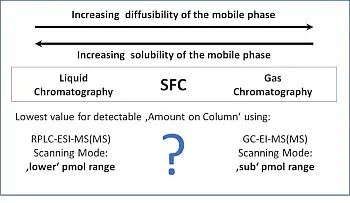
- Fig.1: Illustration for characterizations of liquid chromatography,
supercritical fluid chromatography and gas chromatography
regarding diffusibility, solubility and sensitivity
(using mass spectrometric screening).
Thus, SFC is used as name for this technique now and not interpreted as a strictly supercritical technique. Figure 1 presents the fact of SFC being an intermediate technique of GC and LC in the content of the physicochemical parameters diffusibility and solubility. At the same time, since many years SFC can be used with very robust instrumental systems from different vendors [3], which are basically not very different from commonly known LC systems in appearance and handling. This makes SFC a very interesting separation technique for many (new) users, especially if a greener chromatographic separation technique is needed.
In recent studies, a universal SFC screening method (reflecting polarity-extended chromatographic separation) was applied for a non-target screening strategy (NTS) using HRMS and as a robust, complementary and orthogonal characterization method together with RPLC-HILIC in NTS [4,5]. The huge polarity range of separable molecules and the novel parameters make the technique to a gold standard in NTS [6]. A major requirement for that is high sensitivity in mass spectrometric detection. If a similar sensitivity range of detected compounds can be observed like in GC and LC, SFC would be a perfect complementing option for polarity extended non-target screening applications.
Thus, in this study more than 150 compounds were measured in different concentrations and detected by SFC-ESI-Orbitrap-MS in a NTS screening strategy. The results were applied to assess the lowest detectable concentration for each organic molecule. This quantitative data was also successfully used in a peer-reviewed manuscript together with our colleague Anneli Kruve from Stockholm University about semiquantitative handling of NTS data observed by SFC-MS [7].
Materials and methods
Chemicals and solutions
Acetonitrile, methanol and isopropanol were purchased from Honeywell (Seelze, Germany). Carbon dioxide (CO2) in 3.0 grade was obtained from Gößwein Gas GmbH (Osterhofen, Germany). Information on applied standard compounds (in the log D (at pH 7) range of -7 to +7) is given in a former publication [4] and logP values are additionally listed in the appendix of this manuscript, which can be downloaded as a pdf with the article.
These standards were obtained from ACROS organics (Thermo Fisher Scientific, Geel, Belgium), Alfa Aesar (Thermo Fisher Scientific, Karlsruhe, Germany), Cayman Chemical Company (Ann Arbor, Michigan, U.S.A.), CHEMOS GmbH (Regenstauf, Germany), Dr. Ehrenstorfer (Augsburg, Germany), Merck KGaA (Darmstadt, Germany), Fluka (Buchs, Switzerland), Sigma-Aldrich (Seelze, Germany), Supleco (Bellefonte, Pennsylvania, U.S.A.), and TCI (Eschborn, Germany). They were prepared in individual stock solutions of 1000 µmol/L, dissolved in acetonitrile, acetonitrile/water (50/50, v/v); or methanol and stored at 4°C before use. For analyses, the compounds were combined in mixture solutions which were prepared with levels from 12.2 to 1750 nmol/L.
Instrumental setup
SFC system
The SFC system (Agilent Technologies, Waldbronn, Germany) setup consisted of a degasser, a binary pump with solvent selection valve, an autosampler with 10 μL injection loop, a thermostatically controlled column compartment, a diode array detector and a backpressure regulator unit. The separation was performed, using a CO2 - 20 mM NH4Ac in MeOH gradient from 2 to 60 % within 6 minutes (with 1 min isocratic 2 % B at the beginning) and a 4 min isocratic hold at 60 % B, using a Eurosphere II HILIC column (150 x 3 mm, 3 μm) from KNAUER (Berlin, Germany). The flow rate was 1.5 mL/min, backpressure was set to 130 bar and column temperature was held constant at 40°C. Before entering the ESI source, a constant make-up flow of 200 μL/min water/isopropanol 90 %/10 % was added to the SFC eluting flow.
10 μL of the calibration solutions were injected in triplicate and each separated under these conditions. The calibration solutions were injected in the concentration range from 12.2 nmol/L to 1750 nmol/L, respectively.
Orbitrap mass spectrometer
The chromatographic system was connected to an Orbitrap Exploris 120 mass spectrometer (Thermo Fisher Scientific GmbH; Dreieich, Germany) equipped with an electrospray ionization (H-ESI) source. The source was operated in positive-negative switching mode at spray voltages of 3500 and -2500 V in the positive and negative modes, respectively. Sheath gas, auxiliary gas and sweep gas were set to 50, 8 and 0 (arbitrary units), respectively. The capillary temperature and the vaporizer temperature were set to 350°C. In order to obtain NTS data, a mass range of 67-1000 Da was scanned at a resolution of 60,000 (full width at half maximum at m/z 200). The instrument was fully calibrated before the sequence started and recalibrated (one-point calibration) before every injection. Thus, a mass accuracy of better than 2 ppm could be expected. MS2 spectra were acquired in the data-dependent acquisition mode at a resolution of 30,000 by employing collision energy steps of 15 and 45 V. The four most abundant precursor ions were selected to trigger after one scan cycle and afterwards excluded for 7 s.
Data analysis
Data evaluation was conducted in a targeted approach using TraceFinder 5.1 (Thermo Fisher Scientific GmbH; Dreieich, Germany) based on an in-house compound database, containing the sum formula of all analyzed reference compounds.
The observed retention times and signal intensities (peak areas) were exported with further relevant data about the compounds into a csv-file and were subsequently be used in Excel data analysis format. Therein the lowest detection level in each polarity was observed and marked in lowest detectable levels of 'pmol on column' (poc) applied in this study. The levels were in both polarities 0.1-0.4 poc, 0.4-5.0 poc and 5.0-10.0 poc. A further classification was performed on molecule ionization in positive, negative or both.
Results and discussion
SFC-Orbitrap analysis strategy in NTS
The current SFC-MS setup allows to screen complex samples for very polar to non-polar compounds within 15 minutes (including re-equilibration). This method will be (and is) applied in non-target screening and can be compared/combined with the orthogonal and complementary polarity-extended chromatographic technique of RPLC-HILIC [4,5]. Later chromatographic coupling was recently optimized to a 35-minute run time to meet the demands of modern performance using 'ultra high-pressure' pumps and smaller particles as the stationary phases [8]. With the power of a Exploris orbitrap MS instrument, this offers the chance to comprehensively screen such samples in high-throughput. Since the Exploris 120 MS is capable of analyzing positive and negative ionization mode in parallel, the analysis time can significantly be reduced.
Thus, today the RPLC-HILIC setup allows such analysis within less than 2.5 hours (flushing blank and three replicates of the sample) instead of former 8 hours [8]. In comparison, for the SFC: From initially 2 hours with QqToF systems (1 flushing blank, three replicate analyses of the sample in positive ionization mode, 1 flushing blank, three replicate analyses of the sample in negative ionization mode, each 15 minutes long) the time to analyze one sample could be reduced to approximately 1 hour (1 flushing blank, three replicate analyses of the sample in positive and negative ionization mode in parallel, each 15 minutes). Consequently, this is half of the QqToF comparable analysis duration in which the ionization modes are measured separately. Compared to the 2.5 hours of the RPLC-HILIC-pos/neg ESI-Orbitrap measurements the SFC-pos/neg ESI-Orbitrap is with about 1 hour per sample extremely shorter for NTS measurements.
Furthermore, both techniques together can easily be used as complementary techniques with further mechanistic information from SFC complementing the polarity information of the RPLC-HILIC setup. Last but not least both together are now faster than the original set of measurements with RPLC-HILIC-ESI-QqToF systems only. All in all, a perfect setup and match for routine analysis.
Sensitivity of the applied SFC-ESI-MS
Currently scientists in various disciplines search for known and unknown unknowns in trace levels and in many different matrices. Thus, the combination of a broad scanned mass range and the requirement of a high sensitivity of detection is major challenge in NTS analysis. Initially the overall sensitivity has to be observed in so called 'academic solutions', i.e., compounds in pure solvents, and classified in comparison to the sensitivity observed by using other chromatographic strategies in hyphenation with mass spectrometry (see schedule in Figure 1).
As stated in the last chapter, the molecules are measured in positive and/or negative ionization modes (in the best-case scenario by pos/neg switching) for a most specific and sensitive detection of the organic molecules. Overall, the sensitivity assessment in this type of measurements using SFC-ESI-MS has not been done so far (for such a broad set of molecules). In this study, in total 165 organic substances were scanned in the overall mass range 67 Da to 1000 Da and in a logP range -4.5 to +7.4. All could be detected with the applied screening strategy in the used calibration solutions and all of them with detection levels in the sub- and lower pmol amount on column.
In the subsequent chapters the compounds are grouped in their properties of being ionized (a) in positive ion mode only, (b) in negative ion mode only, (c) in positive as well as negative detection mode -in similar sensitivity-, and (d) in positive as well as negative detection mode -in different but high sensitivities.
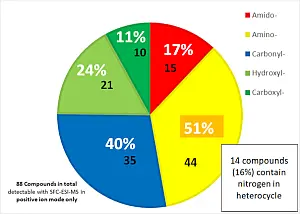
- Fig.2: llustration of functional groups contained
in the positive-only detected compounds
using SFC-ESI-Orbitrap-MS.
A description of included functional groups and other properties as shown in the forthcoming circle-charts give another molecular insight, applying efficient SFC-ESI-MS in various disciplines:
- Compounds detected in positive ion mode only
Figure 2 presents the type (in number and percentage) of functional groups in the 88 compounds detected in positive ion mode only. In about half of them amino- and carbonyl-groups are present and in one-fourth hydroxyl-groups. 14 compounds contain nitrogen as heteroatom in (aromatic) cycles. The compounds in a logP range from -4.5 to +6.2 were detectable very sensitive and their identity is shown in Table S1 in the Appendix. Thereby, 65 compounds could be detected with a LOD below 0.5 pmol compound on column, 20 compounds with a LOD below 5 pmol compound on column, and 3 compounds with a LOD below 10 pmol compound on column. 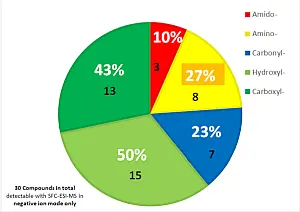
- Fig.3: Illustration of functional groups contained
in the negative-only detected compounds
using SFC-ESI-Orbitrap-MS. - Compounds detected in negative ion mode only
Figure 3 presents the type (in number and percentage) of functional groups in the 30 compounds detected in negative ion mode only. In about half of them hydroxyl- and carboxyl-groups are present and in one-fourth carbonyl-and amino-groups. The compounds in a logP range from -3.4 to +7.4 were detectable very sensitive and their identity is shown in Table S2 in the Appendix. Thereby, 21 compounds could be detected with a LOD below 0.5 pmol compound on column, and 9 compounds with a LOD below 5 pmol compound on column.
- Compounds detected in positive as well as negative detection mode -in similar sensitivity
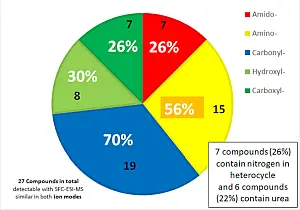
- Fig.4: Illustration of functional groups contained in
the positive as well as negative detection mode
- in similar sensitivity - detected compounds
using SFC-ESI-Orbitrap-MS
Figure 4 presents the type (in number and percentage) of functional groups in the 27 compounds detected in positive as well as negative detection mode -in similar sensitivity-. In more than half of them amino- and carbonyl-groups are present and in about one-third of the compounds amido-, hydroxyl-, and/or carboxyl-groups are present. 7 compounds contain nitrogen as heteroatom in (aromatic) cycles and 6 compounds contain a urea subgroup. The compounds in a logP range from -1.6 to +4.4 were detectable very sensitive and their identity is shown in Table S3 in the Appendix. Thereby, 24 compounds could be detected with a LOD below 0.5 pmol compound on column, and 3 compounds with a LOD below 5 pmol compound on column.
- Compounds detected in positive as well as negative detection mode -in different but high sensitivities
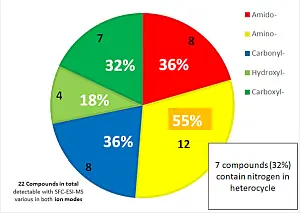
- Fig.5: Illustration of functional groups contained in
positive as well as negative detection mode
-in different but high sensitivities- detected
compounds using SFC-ESI-Orbitrap-MS.
Figure 5 presents the type (in number and percentage) of functional groups in the 22 compounds detected in positive as well as negative detection mode -in different but high sensitivity-. Again, in more than half of them amino- groups are present but also in about one-third of the compounds amido-, carbonyl, and/or carboxyl-groups as well. 7 compounds contain nitrogen as heteroatom in (aromatic) cycles. The compounds in a logP range from -2.6 to +4.3 were detectable very sensitive and their identity is shown in Table S4 in the Appendix. Thereby, 8 compounds could be detected with a LOD below 0.5 pmol compound on column, 12 compounds with a LOD below 5 pmol compound on column, and 2 compounds with a LOD below 10 pmol compound on column.
Screening point of view
Organic molecules with various functional groups and different polarities can be screened very sensitive using modern SFC-ESI-MS in pos/neg switching in a huge range of detected ion masses.
This set of positively detectable compounds predominantly contain amino- and carbonyl- groups as well as nitrogen in a heterocycle (and some in urea). The -in positive ionization mode- detected molecules often contain also hydroxyl- and amido-groups.
This set of negatively detectable compounds predominantly contain carboxy- and hydroxyl- groups. The -in negative ionization mode- detected molecules often contain also amino- and carbonyl- groups.
Conclusions and Outlook
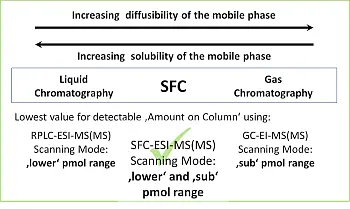
- Fig.6: Final illustration for characterizations of
liquid chromatography, SFC and gas chromatography
regarding diffusibility, solubility and observed sensitivity
(using mass spectrometric detection).
The complementary chromatographic strategy 'SFC' with its special (polarity-extended) separation capabilities and complementary NTS information as well as low LODS should now really be handled as new gold standard in Non-Target Screening [6]
Furthermore, SFC users should be encouraged to take this option more often into consideration for really challenging chromatographic separations (now also in trace levels).
Acknowledgements
We acknowledge Thermo Fisher Scientific for the successful collaboration and solutions (especially since we used the SFC hyphenation from another vendor). Special thanks go to Sylvia Grosse, Claudia Halter, Albert Hermann, Reza Dabiri, Olaf Scheibner and Frank Steiner for technical support and fruitful discussions. We further acknowledge the financial support from the German Federal Ministry of Education and Research for funding the project RIKovery (grant number: 02WV1569E) within the funding measure "Water technologies: Reuse" (WavE II).
References
- S. Bieber und T. Letzel (2015) SFC-Superkritische Fluid Chromatographie oder Science Fiction Chromatographie?; Analytik News, 08.01.2015
- S. Bieber, H.-G. Döteberg, G. Greco, S. Kromidas und T. Letzel (2016) HPLC-Tipps Band 3: Gradient, HILIC, SFC und Trends in der HPLC (Pirrot-Verlag; Editor: S. Kromidas), 22.11.2016) ISBN 978- 3-937436-58-6.
- S. Bieber und T. Letzel (2015) Potential der SFC: Von analytischer, präparativer, chiraler und achiraler Trennung, Analytik News, 02.07.2015
- S. Bieber, G. Greco, S. Grosse, and T. Letzel (2017) RPLC-HILIC and SFC with mass spectrometry: Polarity-extended organic molecule screening in environmental (water) samples; Analytical Chemistry, 89, 7907-7914.
- S. Bieber and T. Letzel (2018) Orthogonal separation techniques to analyze (very) polar molecules in water samples: Assessing SFC and Reversed-Phase LC-HILIC; LCGC Europe 31(11): 602-606.
- S. Bieber and T. Letzel (2021) Achiral SFC Separations - Gold Standard for the Next Generation of Non-Target Screening; Analytical Science Advances, -10.
- S. Bieber, T. Letzel, and A. Kruve (2023) Electrospray Ionization Efficiency Predictions and analytical standard free quantification for SFC/ESI/HRMS; Journal of the American Society for Mass Spectrometry 34(7), 1511-1518.
- S. Bieber and T. Letzel (2022) Technical Note - Serial RPLC-HILIC coupling hyphenated with Orbitrap mass spectrometric detection: Next generation in Non-Target Screening, AFIN-TS Forum, November (8): 1-10.
Bieber S. and Letzel T. (2023) Technical Note - Supercritical Fluid Chromatography coupled to an Orbitrap Exploris 120 mass spectrometer - Quantitative Viewpoint, AFIN-TS Forum; August (9): 1-13.
